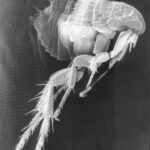When Alley first came into my life, I became a first time cat owner. I never thought about a cat having tapeworms. But apparently they can, as I came to realize about a year ago. There are both visible and non-visible signs of tapeworms in cats, which I’ll cover later. But if, like me, you find signs of tapeworms you will probably wonder just where they came from, so let’s cover that first.
Tapeworms are a part of a life cycle. One possible sign of tapeworms in your cat would be a large flea problem. This is because the fleas have tapeworm eggs inside of them. When an animal eats a flea, the eggs are ingested into the animal. When the eggs pass from flea to animal, the tapeworm now has a warm body to grow in. When the animal either passes the tapeworm out of its system, or dies from it, the tapeworm is out in the open; when the tapeworm dies, its eggs are ingested by fleas, which then hop onto the next passing animal. And then the cycle repeats.
So now that you know how tapeworms get into cats, lets look at how to tell if you have a problem. The first visible sign, as I said above, is a large flea infestation. This is especially true if your cat, like my Alley did, loves to go outside. The way the flea gets to the cat is simple, and to some – gross. Outside cats hunt. Alley used to hunt squirrels. Squirrels are known for fleas. When a cat kills the prey, they will eat some of it; this is how the flea gets into the cat. If your outdoor cat has fleas, more than likely it ate one or two. This could be the first sign to watch for tapeworms in your cat.
Another sign of tapeworms in cats is the little rice-looking pieces you find everywhere. When Alley would come in, I’d find them on the floor, the table, and the desk. At first I wondered where she was getting rice. Then I saw one move, then another. These “grains” are parts of the tapeworm which came out of the anus of the cat. If you spot these white grains in number, check the litterbox. If you spot them in the litterbox you need to look under the cats tail to see how bad the infestation is. You will see these same white “grains” around the anus; and most likely they will be moving.
Another visible sign of tapeworms in cats is blood in their urine or stool. It will be a shiny red with little white specs. The specs are the remains of tapeworms. If you spot blood, this means the tapeworm has entered the bloodstream. This is a potentially dangerous sign of tapeworms in cats because this means that the tapeworm can work itself into the heart, causing heart problems.
There are also non-visual signs of tapeworm problems in cats. Alley had the first sign listed above, and this next sign. Overeating or odd eating patterns. Cats with tapeworms tend to eat more than usual or in greater amounts. It will seem as if the cat thinks she is starving or may not get another meal. If, when you give your cat his food, he dives into it like he hasn’t eaten since last week, check for the little white “grains”. Cats, unlike dogs, do not gobble up everything in sight.
If your cat takes on a potbellied appearance, this could be another sign of tapeworms. In cats, fatty tissue doesn’t show in just one area like humans or dogs. If a cat is getting fat, it gets round all over. If a cat has a potbellied look, it is sick. This is a similar thing to humans who do not have enough nutrition in their diet. Tapeworms in cats take most of the nutrients out of the food, leaving the cat with an empty feeling. This causes the body to react and the bloated stomach. The more you feed the cat, the less nutrition they will get.
Another sign which Alley showed was frequent and difficulty with urination. She seemed to be using the litterbox twice as much, and taking longer to urinate. Also, if your cats stool appears to be constantly runny, this is another issue. Other signs along with this include a frequent licking of the genital area to get rid of the tapeworm, fever and persistent coughing. Which brings up another sign of tapeworms in cats.
We all know cats cough up hairballs. If a tapeworm works its way into your cats stomach, the cat will have an involuntary reaction to it. Like hairballs, a cats stomach will force out the tapeworm. So if she starts gagging and coughs up a whitish glob, that’s a tapeworm. Your cat will vomit until the tapeworm is out of his system. If your cat does this more than once in a short time period, he has a serious tapeworm problem and needs to see a vet.
There are more serious signs of tapeworms in cats as well. A loss of apatite and listlessness can signal a larger infestation of tapeworm and will require immediate care. If you notice these signs, along with the signs listed above, the problem is more progressed than it appears. Tapeworms in cats, while not a major problem most times, can become a serious issue if it gets to this point.
Once you have spotted the signs of tapeworms in your cat, you need to see a veterinarian. They will be able to provide medication to help alleviate the problem. This will often require a pill which your cat will need to take via mouth. It will not be fun, as your cats gag reflex will kick in. Once the cat has taken the medication, she will need to remain indoors for about two days. This ensures the tapeworms which are already there are killed; as well as no new tapeworm eggs are ingested.





